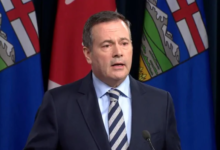Ontario could run out of ICU beds, ventilators in 37 days even if COVID-19 rates cut in half: study
A new study by some of Ontario’s leading medical researchers paints an alarming picture of the strain on the health-care system as the number of COVID-19 cases continues to rise, suggesting the province will run out of intensive-care beds and ventilators in just 37 days, even if it manages to cut current infection rates in half.
The study, by a team from the University of Toronto, University Health Network and Sunnybrook Hospital, among other institutions, warns of “significant strain” on crucial health-care resources in the weeks ahead, calling for measures to “rapidly identify and create opportunities for additional capacity to care for critically ill patients.”
As of Thursday, Ontario has 258 confirmed cases. Of those, five are considered resolved, with the virus linked to two deaths.
Over the past eight days, since March 12, the daily increase in new COVID-19 case numbers in Ontario has averaged 26 per cent. Since Monday, the rate of increase has slowed, but has still averaged 15.6 per cent daily over the past four days.
“Our simulation using a ‘conservative scenario’ of a daily 7.5 per cent increase of cases predicts that Ontario’s ICU bed and ventilator resources will be depleted in approximately 37 days,” says the report published Wednesday evening.
“Ward beds will be full and unable to accommodate new patients in approximately seven weeks.”
Goal to help leaders make informed decisions
It’s a startling conclusion, but one that Beate Sander, lead study author and scientist at the University Health Network, says isn’t meant to spark panic.
Instead, she says, the goal is to put the pressures on the healthcare system into context so that medical and political leaders can make informed decisions.
The study authors acknowledge their modelling is based on a number of key assumptions:
- They begin with a starting point of 250 cases, which Ontario hit Thursday.
- They assume that 19 per cent of cases will require hospitalization.
- They assume that 26 per cent of hospitalized patients will require an ICU bed.
- They assume an average ICU stay will be eight days long.
With those assumptions in mind, they predict the following outcomes:
- If Ontario can free up 25 per cent of ICU beds for COVID-19 patients, resources will be depleted in 37 days.
- If 75 per cent of ICU beds can be allocated to COVID-19 patients, resources can last 52 days.
- If, on top of 75 percent of ICU beds, Ontario can make available some 2,000 more beds and 600 additional ventilators, resources can last 60 days.
The models don’t account for the impact of the recent border restrictions or school closures — measures Sander hopes will slow the rate of infection and ease the pressure on Ontario’s already strained health-care system.
Social-distancing likely needed for 2 months or more
“I think if we are really diligent with all the public-health measures, I think we can do better… What we call the ‘conservative scenario’ might be the likely scenario — but I’m hoping for something even less severe.”
So far, the daily growth rate has fallen below the 7.5 per cent mark only once since March 10. That was on Tuesday, when only 12 new positive cases were confirmed, an increase of 6.8 per cent from the previous day.
Flattening the curve of infection and increasing the province’s access to beds and ventilators could extend the life of the system to two months, says Sander. But expect to remain in your home for at least another four weeks, she adds.
“All my epidemiologist colleagues will tell you we probably need to have it in place for much longer … For sure, more than four weeks and probably more than two months,” Sander said.
Health Minister Christine Elliott insisted Ontario is “building capacity,” when asked about the study at a news conference Thursday.
“We don’t know exactly what’s going to happen but we do know that the pressures on our health-care system are going to increase,” Elliott said.
Province working to increase capacity
Elliott said the province is working to increase the number of available beds, and recently increased its in-house supply of ventilators by 300. The province is also in talks with auto-parts manufacturers about possibly retooling their equipment to help produce ventilators.
“Were also looking at other alternative measures where we can perhaps place some people who are at an alternate level of care that are currently in our hospitals to a setting that is going to be safe for them and appropriate for them,” Elliott added.
Dr. Anand Kumar, a critical-care doctor at Winnipeg Health Sciences Centre, conducted similar modelling during Canada’s H1N1 outbreak of 2009 with a group of medical professionals with the Critical Care – Infectious Diseases Network, Canada.
But there was one key difference. With H1N1, an anti-viral was available almost immediately and a vaccine was ready in about five months.
Without them, he says, the modelling looked very much like Sander’s.
“I think the results are well within the realm of possibility,” Kumar said of the COVID-19 study.
‘A really risky situation’
Kumar pointed out in a recent newspaper op-ed that Canada’s hospitals typically operate at 90-to-95 per cent capacity and were stretched with this year’s flu season alone.
“This is a really risky situation and we need to be prepared for exactly the kind of predictions that this group is suggesting,” he said, calling for a more coordinated approach to social distancing practices across the country.
The researchers behind the COVID-19 study add their model doesn’t take into consideration what happens if Ontario can boost its resources. If the province’s ventilator stockpile grows, the modelling could become much more promising.
One other factor they don’t account for has to do with human resources. The study assumes all beds are fully staffed. Nurses, doctors and medical staff becoming ill could throw the projections out the window.
“A ventilator alone isn’t that helpful. So there needs to be ventilator and there needs to be an ICU bed and there needs to be a qualified staff … Just the technology alone, it’s not going to do it,” Sander pointed out.
Asked about the study Wednesday afternoon, Ontario’s Associate Medical Officer of Health Dr. Barbara Yaffe suggested treating the results with caution.
“At the end of the day they are modelling, and that may or may not reflect what happens,” she said.
The study authors advise caution too, saying their model is preliminary and evolving, with new data every hour that could change the odds. And with much of Ontario doing its part to self-isolate, the goal is that those odds change for the better.
Asked if Ontario can bring the daily growth rate of new cases below 7.5 per cent, the province’s Chief Medical Officer of Health Dr. David Williams responded, “I’d like to think we can.”
CBC








Redes Sociais - Comentários